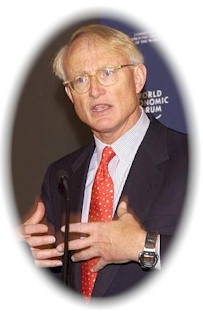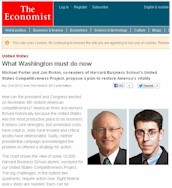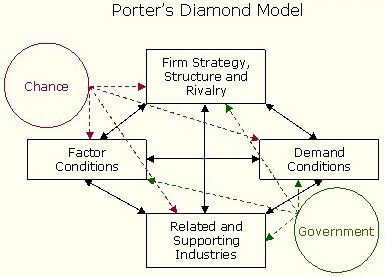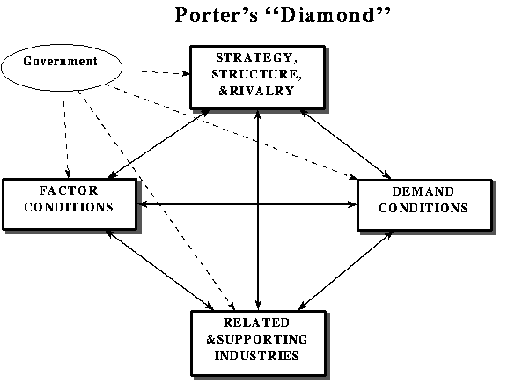COMPETITIVENESS
- Porter

| INTERNATIONAL
COMPETITIVENESS - Porter |
 |
| INTRODUCTION | This unit will
cover
|
| Why We have competition | Competition
is the essence of capitalism. Companies make a product, and people buy
it based upon their opinion that it is the best price for the best quality
they can get. If a company makes a product at a price which is too high,
other companies will seek a way to undercut them and steal their customers
away - it sounds like it is not very nice, but, that is the real world.
With a world growing smaller due to the pressures of globalization, which
is greatly facilitated by
The original company has the choice of cutting production costs to meet this competition, or using marketing promotion techniques to try to convince their customers to stick to buying the original product at the higher price because of quality reasons or cultural reasons. This is the "arena" of international
competitiveness in the early years of the new millenium and there are a
number of things we need to learn about in order to understand how Canada
and Canadian companies are challenged by the global competitive environment.
|
Prof.
Michael Porter
Porter at the World Economic Forum in Switzerland |
Prof. Porter
of Harvard University is known internationally as a leading expert
on corporate strategy. He has written a number of famous books and articles
on strategy which have been widely quoted and used in many university courses
on management strategy at the graduate and undergraduate level.
Wikipedia says Porter is a "A six-time winner of the McKinsey Award for the best Harvard Business Review article of the year, Professor Porter is the most cited author in business and economics" (Canada's Mintzberg won this award twice) Porter is most well known for his Five Forces analysis which originally developed in 1979.
|
| Michael
Porter |
Dr. Porter has
also developed many links with the University of Toronto and collaborated
with a number of UofT professors on various "competitiveness" projects
and research.
One of the recent collaborations Porter had with UofT was research conducted with Prof. Roger Martin. Martin [2012] serves as Dean of UofT's Joseph L. Rotman School of Management. In 1991 Prof. Martin, along
with Prof. Porter (and John Armstrong), published Canada at the Crossroads.
This report looked at the Canadian economy. In 2001, Porter and Martin
released Canadian Competitiveness: A Decade after the Crossroads.
In the 2002 report they found that Canada is lagging in the global competitiveness
race. "In 1991," says Martin, "Canada was the third-richest country in
the world in GDP per capita, and had a dollar valued at 87 cents U.S. By
the time we released our follow-up study, Canada was in fifth place and
had a dollar valued at 65 cents U.S., representing a 23 per cent pay cut."
|
| Porter
U.S. competitiveness  |
Nov
2012
Writing after the election of Pres. Obama to a 2nd term, Prof. Porter and Prof. Rivkin of Harvard Business School authored and article in the Nov 2012 issue of The Economist in which they discussed what Washington must do now. http://www.economist.com/news/21566352-michael-porter-and-jan-rivkin -co-leaders-harvard-business-schools-united-states-competitiveness Porter and Rivkin explain
Their "recipe" includes
|

| "Porter's 'Diamond' proposes
several basic elements which govern a country's trading competitiveness.
The theory propounds demand, factor and inter-firm conditions as the rudiments
of a healthy open economy."
Barbara J. O'Toole http://econserv2.bess.tcd.ie/SER/1996/btoole.htm "He [Porter] argues that the factor endowment theories of Heckscher and Ohlin are too simplistic to determine a nation-state's competitive advantage. Comparative advantage can no longer be seen as 'divine inheritance'. Porter states that international success in a particular industry is determined by four broad mutually reinforcing factors which create an environment which enables these firms to compete. The four include factor conditions, demand conditions, related and supporting industries and firm structure, strategy and rivalry. These determinants also being influenced by the nation's government and by chance events." |
International competitiveness
determined by
|
| In a number
of textbooks dealing with international business, the author sometimes
includes a diagram representing Porter's "diamond", which is similar to
the diagram above.
The important point is that all 4 of these conditions need to be favourable in order for an industry, within a particular country, to achieve worldwide success.
|

The diagram above comes
from the site of Prof. Keith Head, Associate Professor , Strategy and Business
Economics Division, at UBC and is reproduced here with his permission given
in a Jan 18th 2001 email. Copies of emails are kept in the permissions
binder
see http://pacific.commerce.ubc.ca/keith/Lectures/diamond.html
.
| KEY
POINTS |
The point of discussing
Prof. Porter's "diamond", is that once you understand some theories of
why countries trade - it is reasonable to discuss the point that
- "countries do not trade - companies do"; therefore Porter's theory
is useful in order to look at why companies trade and what are the conditions
that allow for a company to have competitive superiority.
WTGR |
 |
Porter's theory has been widely adopted and there are many examples of where people use it to speculate how an entire country should be planned. Example - Nepal |
| In this article from Nepal
News, Navin Dahal explains how Nepal could benefit from adopting some of
the principles that Porter theorizes.
"Asking "How can Nepal be competitive?" will lead us nowhere as countries do not compete, companies do. The very notion of a country being competitive is misleading. No country in the world, even Japan and the USA, is competitive in all industries. A country can be globally competitive only in a few industries. Thus the right question to ask would be "In which industry or industries can Nepal be competitive?" Answering this will require an understanding of what makes a country competitive in a particular industry.
Go here www.nepalnews.com....../2000/aug/economy.htm to read the entire article |
.
| Porter and the role of government | A key part of Porter's theory
is his description of what government should and should not do to help
business, or stay out of the way off innovation.
Porter is saying great government policy can't help companies of the country be competitive. Companies have to be competitive by striving for things beyond that which their host government can effect. This does not "release" governments from responsibility to help companies - it simply recognizes that government is not the total answer. Understanding this point
is critical for students of international business in Canada since it should
be recognized that Canadian companies (in the opinion of many observers)
are much more coddled than U.S. companies.
WTGR |
|
|
CONTACT I MAIN PAGE I NEWS GALLERY I E-BIZ SHORTCUTS I INT'L BIZ SHORTCUTS I MKTG&BUSINESS SHORTCUTS I TEACHING SCHEDULE |
| . | |
| MISTAKES ITEXTS USED I IMAGES I RANK IDISCLAIMER I STUDENT CONTRIBUTORS I FORMER STUDENTS I | |
| . |